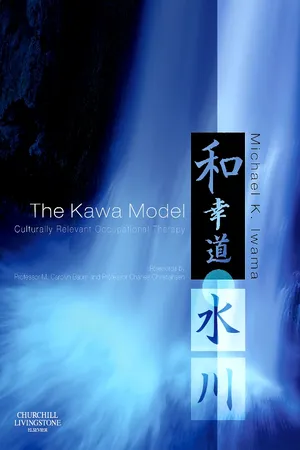
- 260 pages
- English
- PDF
- Available on iOS & Android
About This Book
A landmark publication in occupational therapy and a significant contribution to the rehabilitation theory literature! The Kawa Model presents a new conceptual model of practice that differs from contemporary theories in regard to: origin (East Asia), underlying philosophical base (East Asia), being heavily infused with a natural-ecological, holistic world view, and relational structure. The model is based on the metaphor of nature (a river) that stands for the meanings of life. Because of the familiarity of the metaphor, to both therapists and clients alike, the Kawa Model is relatively easy to comprehend, remarkably simple, yet comprehensive and effective. Unlike other models, it was raised from clinical practice, by practitioners, through a process of qualitative research methods. It is the first conceptual model and substantial theoretical work of occupational therapy from outside of the Western world.
- A 'must-read' for all students of occupational therapy
- The first substantial work in occupational therapy from outside of the Western world
- Introduces an Eastern perspective on matters of theory and culture in occupational therapy
- Eight case studies, four from Western practice contexts and four from the East
- Developed by clinicians and practitioners for their peers
- Questions the cultural boundaries of occupational therapy, its knowledge (epistemiology), theory and practice. It puts the reader in touch with the cultural nature of self, client and profession
- Enables readers to develop critical analysis skills for examining matters of theory and culture, as opposed to learning theory as 'recipes'
Frequently asked questions
Information
Table of contents
- Front Cover
- The Kawa Model
- Copyright Page
- Contents
- Foreword
- Foreword
- Preface
- Chapter 1. Situating occupational therapy's knowledge: Why alternative conceptualisations and models of occupational therapy are required
- Chapter 2. Cross-cultural concepts as the building blocks of conceptual models: occupation
- Chapter 3. Occupational therapy teory: cultual inclusion and exclusion
- Chapter 4. Context and theory: cultural antecedents of the kawa model part 1
- Chapter 5. Context and theory: cultural antecedents of the kawa model part 2
- Chapter 6. Raising a new, culturally relevant conceptual model of occupational therapy from practice
- Chapter 7. An overiew of the kawa model
- Chapter 8. Applying the kawa model: comprehending occupation in context
- Chapter 9. Rivers in context: brief narratives and cases demonstrating usesof the kawa model
- Chapter 10. Towards cultually relevant and safe theory in occupationl therapy
- Index